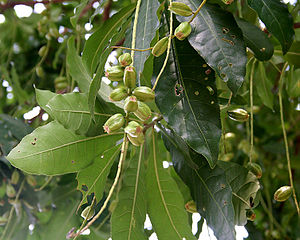Note: This is a project under development. The articles on this wiki are just being initiated and broadly incomplete. You can Help creating new pages.
Barringtonia acutangula - Samudraphala
Samudraphala is an evergreen tree. It's Sanskrit name is Hijja or Hijjala. The fruit is spoken of as Samudra-phala and Dhātriphala.
Uses
Parts Used
Chemical Composition
The bark contains tannins (16%), also ellagic acid. The fruits contain triterpenoid sapogenins.[2]
Common names
| Language | Common name |
|---|---|
| Kannada | Dhatri phala, Ganigalu |
| Hindi | Hijjal, Samandarphal |
| Malayalam | Arrupera, Athambu |
| Tamil | Adampai, Amamikkatampu |
| Telugu | Karpura-Bendakanapa chettu, Kanigi |
| Marathi | Tiwar, Newar |
| Gujarathi | NA |
| Punjabi | NA |
| Kashmiri | NA |
| Sanskrit | Ambuja, Samudraphala |
| English | Barringtonia, Freshwater Mangrove |
Properties
Reference: Dravya - Substance, Rasa - Taste, Guna - Qualities, Veerya - Potency, Vipaka - Post-digesion effect, Karma - Pharmacological activity, Prabhava - Therepeutics.
Dravya
Rasa
Tikta (Bitter), Katu (Pungent)
Guna
Laghu (Light), Ruksha (Dry)
Veerya
Ushna (Hot)
Vipaka
Katu (Pungent)
Karma
Vata
Prabhava
Habit
Identification
Leaf
| Kind | Shape | Feature |
|---|---|---|
| Simple | Alternate | Alustered towards the tip of branchlets. |
Flower
| Type | Size | Color and composition | Stamen | More information |
|---|---|---|---|---|
| bisexual | 6-8 mm long | Red | Many | terminal pendulous racemes. |
Fruit
| Type | Size | Mass | Appearance | Seeds | More information |
|---|---|---|---|---|---|
| Berry | 2.5-3.8 cm long | Oblong-ovoid, bluntly quadrangular; seed one, ovoid | {{{6}}} |
Other features
List of Ayurvedic medicine in which the herb is used
Where to get the saplings
Mode of Propagation
How to plant/cultivate
Seeds are soaked in boiled water and allowed to cool for 24 hours before sowing. [6]
Commonly seen growing in areas
Photo Gallery
References
External Links
Categories:
- Ayurvedic Herbs known to be helpful to treat Fever
- Ayurvedic Herbs known to be helpful to treat Diarrhea
- Ayurvedic Herbs known to be helpful to treat Bronchitis
- Ayurvedic Herbs known to be helpful to treat Splenomegaly
- Ayurvedic Herbs known to be helpful to treat Headache
- Herbs with Leaves used in medicine
- Herbs with Roots used in medicine
- Herbs with Fruits used in medicine
- Herbs with Bark used in medicine
- Herbs with common name in Kannada
- Herbs with common name in Hindi
- Herbs with common name in Malayalam
- Herbs with common name in Tamil
- Herbs with common name in Telugu
- Herbs with common name in Marathi
- Herbs with common name in Sanskrit
- Herbs with common name in English
- Habit - Tree
- Index of Plants which can be propagated by Seeds
- Herbs that are commonly seen in the region of Tropical area
- Herbs that are commonly seen in the region of Coastal area
- Herbs
- Plants of western ghats
- Tree
- Ayurvedic herbs that don't have seed photos
- Lecythidaceae





